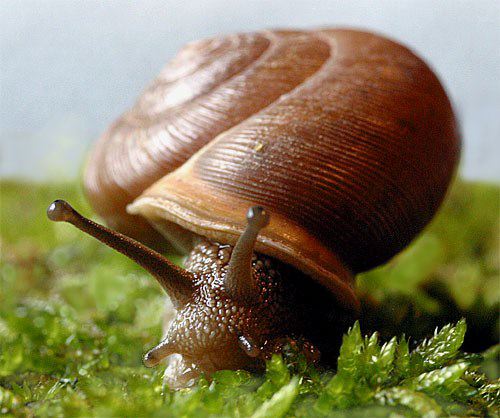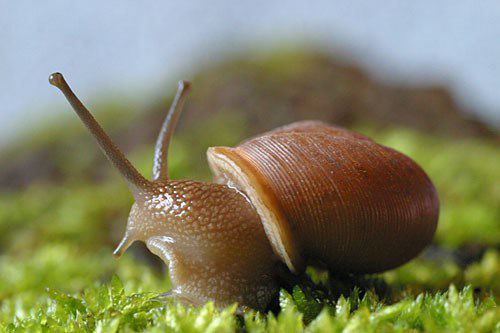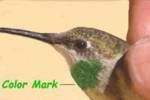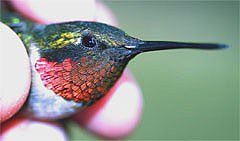|
|
|||
|
|
|||
|
SLOWLY, BUT SURELY We've been a little slow at posting this week's photo essay from Hilton Pond. It wasn't that we were too busy doing other things, it's just that our current subject's general lethargy seemed to be contagious, and everything we did to prepare transpired at increasingly slower speeds. It took us forever to photograph the subject--even longer to try to identify it--but at last we finished our tasks and now present our first ever installment about the sloooooow-moooooving land snails of Hilton Pond Center.  Land snails--along with such creatures as aquatic and marine snails, slugs, and nudibranchs--are all mollusks (also spelled "molluscs"). Their phylum name is pretty straightforward--Mollusca--and comes from a Latin word meaning "soft." An animal gets to join this ancient group if it has a soft unsegmented body plus a mantle--an organ that secretes the calcareous (calcium-based) substance that forms the shell. Mollusk taxonomy is complex and includes eight classes, but the more-familiar shelled mollusks are divided into two major groups. The Bivalves have hinged two-part shells, or valves, whose halves are mirror images--as in the Eastern Elliptio, Elliptio complanata (below right), collected from a drought-exposed bank of Hilton Pond; also included are such tasty items as mussels, oysters, and scallops. Species in the other big group, generically called "univalves," have a single shell that is spiral- shaped; this includes our recently encountered land snail (top photo, grazing on moss) as well as conchs, whelks, cowries, and the freshwater snails kept in home aquaria. Animals one might not expect to be mollusks are the cephalopods ("head foot")--octopi, squid, cuttlefish, and nautilus--which have the largest invertebrate brains. The nautilus forms an elaborate external shell, while most of the rest have internal ones; that of the cuttlefish is the "cuttlebone" used to provide calcium to cage birds. Nearly 80% of the 50,000-plus named mollusks are "univalves," known more formally as the Gastropoda. A quick look at any of them will explain where this class name comes from; "gastropod" means "stomach foot" and that's exactly what sticks out of the shell of our land snail.
We found our "This Week" snail dining slowly inside a wire ground trap we use to capture birds for banding. The floor of the trap was covered with cracked corn and millet, and the snail apparently found this scratch feed to its liking. We carefully extricated it from the trap and placed it in a clear glass jar, where we observed it for a few days. When we offered it a choice of leaf lettuce and a piece of flour tortilla, it slowly chose Mexican and ignored the greens. Land snails can eat and breathe slowly at the same time, since the mouth is anterior and the lung opening is on the side of the foot near the edge of the mantle and just anterior to the edge of the shell (left). In an apparent design flaw, the anus lies adjacent to the breathing hole, just above the head and mouth. This arrangement works just fine for snails, of course, but may explain why some folks don't like escargot. Although we have referred to our snail as "it," we might be more correct in saying "he/she" because many gastropods are true hermaphrodites, serving slowly but simultaneously as both male and female. Regardless, they still pair up to copulate--all in slow-motion, of course--and in some species each snail stimulates the other with a needle-like, calcareous "love dart" during the embrace. As novitiates into the world of mollusk identification, we admittedly found it difficult to key out the land snail we found at Hilton Pond Center; for us, it was really slow-going. As might be expected, terrestrial gastropods are classified in part on shell characteristics, but finding all these traits on a live snail isn't as easy as it might sound. After narrowing things down a bit, we then had to consider whether the snail's shell was elongate, globose, or depressed; lipped (and reflected?); higher than wide, or vice versa (in this case, about .75" in diameter by .5" thick); and whether the back side of the shell was imperforate or with an obvious or half-hidden umbilicus (a belly-button-like depression, below left). Using John Burch's How to Know the Eastern Land Snails, we slowly worked through unfamiliar mollusk terminology and the above comparisons--along with many, many more--to finally conclude our Hilton Pond gastropod is the White-lipped Globe, Mesodon thyroidus, a species common throughout most of the eastern and central U.S. (At first we thought it could be M. clausus, the Yellow Globelet--also found in the East from North Carolina northward--but then it apparently would be a South Carolina state record.) We may have taken a wrong turn in the identification key, however, so we're certainly willing listen to malacologists (shell specialists) who have better understanding of gastropod taxonomy. If we need to, we can ship the organism to any expert--by snail-mail, of course--but please correct us immediately, lest we come to believe that everything associated with land snails is as sloooooooooow as what we've experienced so far at Hilton Pond Center.  If you enjoy "This Week at Hilton Pond," please help Support Hilton Pond Center for Piedmont Natural History. It's painless, and YOU can make a difference! You may wish to consult our Index of all nature topics covered since February 2000. |
|
Hummingbird Super-stimulus Experiment 2003 and attract migrant hummers Just visit the site for Operation RubyThroat: The Hummingbird Project by clicking on the link above  Please report your sightings of Please report your sightings ofColor-marked Ruby-throated Hummingbirds |
 This fresh-plumaged male banded on 5 April was the first spring migrant of its species to arrive at Hilton Pond; two more followed on 7 April. This is the third consecutive year that the first RTHU arrived locally on 5 April.
SPECIES BANDED THIS WEEK Ruby-throated Hummingbird--3* Chipping Sparrow--8 Northern Cardinal--1 Brown-headed Cowbird--2 * = New species for 2003
NOTABLE RECAPTURES (with original banding date, sex, and current age) White-throated Sparrow (2) 01/09/99--after 5th year unknown 11/06/00--4th year unknown |
WEEKLY BANDING TOTAL YEARLY BANDING TOTAL (2003) 18 species 438 individuals BANDING GRAND TOTAL (since 28 June 1982) 123 species 42,552 individuals
OTHER SIGHTINGS OF INTEREST --Two female Wood Ducks continue to incubate in nestboxes on Hilton Pond. --Continuing spring rains and excessive wind made mist-netting impossible almost every day this week; even trapping did not fare well. The good news is that Hilton Pond remains full and the underlying aquifers undoubtedly are beginning to be replenished after four years of drought.
|
|
Up to Top of Page Current Weather Conditions at Hilton Pond Center |
|
Hilton Pond Center for Piedmont Natural History |
 post questions for The Piedmont Naturalist |
 Nature Study Network |
Hilton Pond Center |
|
|